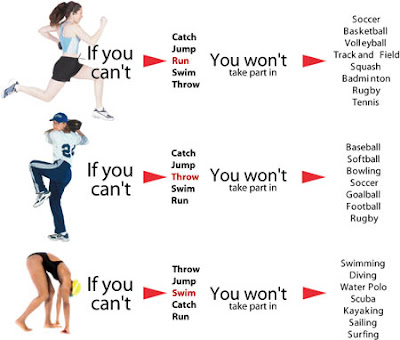Ultimately what value is there in physical activity and why should we teach it in schools?
Physical Health
It is commonly acknowledged and supported by a large body of research the claims that physical activity reduces the prevalence of a variety of different chronic diseases. This includes some of the most common diseases responsible for premature death, such as heart disease, various cancers, diabetes, high blood pressure and more(PHAC 2016). Through regular physical activity we have the ability to reduce the chances of developing these preventable diseases. Physical activity for the purposes of disease prevention and longevity are meaningful enough reasons alone to engage in physical activity and to teach these benefits to future generations.

An example of how fundamental movement skills impact opportunities to become active further in life (http://www.phecanada.ca/programs/physical-literacy/what-physical-literacy/fundamental-movement-skills)
In addition to the health benefits of physical activity, physical activity also improves your ability to carry out daily tasks and activities. It is in my belief that all children should be what is known as physically literate. Physical literacy is comprised of having a competent skill set of what are known
as fundamental movement skills. These fundamental movement skills include running, throwing, catching, jumping, striking, kicking, agility, balance and coordination. Teachers have an opportunity to teach these skills through various activities and sports that will then shape the way in which children will interact with the world for the entirety of their lifespan.
Mental Health
In addition to the physical benefits to physical activity there are a host or reasons to why physical activity is an important aspect of mental health. According to a study physical activity, including jogging, swimming, cycling, walking, gardening, and dancing, have been proved to reduce anxiety and depression. These improvements are proposed to be caused by exercise-induced increase in blood circulation to the brain and by an influence on the hypothalamic-pituitary-adrenal (HPA) axis and, thus, on the physiologic reactivity to stress.(Sharma, A., Madaan, V., & Petty, F. D. 2006). There has also been some evidence to suggest that physical activity can allow people to better cope with distractions, and improve self-efficacy, mental alertness and enhance social interactions. If we want our children to have health bodies and healthy minds that can live up to their potential physical education needs to be a priority not an option.

(http://www.newmansu.org/mental-health-awareness-week.html)
Social Literacy and Character Building
Beyond the Mental and Physical benefits there are a host of social and culture benefits that are passed onto children through teaching physical education. Physical education places children in an environments where they develop their social skills and character through facing challenges and adversity. This can span learning how to communicate effectively, building meaningful relationships, developing real world problem solving skills and being able to think strategically (both on a team and individual level). Physical activity also provides a safe environment to learn how to cope and manage emotions spanning the spectrum of absolute elation to misery. Physical activity requires that the participants take some form of action to achieve a particular goal. I think that working towards either a directed or self directed goal fosters the development of sound work ethics, self confidence and entrepreneurial spirit.

(https://storify.com/afterschoolAE/40-awesome-resources-how-team-sports-benefits)
Community Engagement and Unity
Physical Activity has the power to build community and minimize the persevered differences that have been socially constructed. Sharing the common goal within a specific activity acts as a social glue that creates meaningful bonds. This can be seen in almost any physical activity whether that be an individual activity like running to a worlds most popular sport, soccer. Physical activity is a commonality that all people can all share and empathize with. As an example in 2012 the London Summer Olympics were viewed by over 4 billion people over the span of 17 days, and 205 different countries came together to peacefully participate in the games. There is a popular anonymous quote that goes to say "You can discover more about a person in an hour of play than in a year of conversation"

(https://en.wikipedia.org/wiki/2012_Summer_Olympics#/media/File:2012_Olympics_opening_ceremony_fireworks_1.jpg)
Personal Achievement and Enjoyment
One big reason why everyone should be physically active is because it can be very rewarding and fun. People spend huge amounts of time and money on various physical activities merely for the enjoyment of part taking in these activities. Sir Edmund Hillary was famously asked "Why did you climb Everest?" and his answer was "because it's there". I feel that this explanation speaks to the justification to why anyone should do any physical activity. Why should anyone run in circles on a track? Why should someone should swim in lanes at a swimming pool? Why should someone ski down hills only to do it again and again? The simple act of challenging the body and mind provides enough of an inherit reward to justify the means. This is something that is very subjective but in many ways is the root to why physical activity, sports and athletics can be seen in all cultures throughout the world.

(http://www.newmansu.org/mental-health-awareness-week.html)
Social Literacy and Character Building
Beyond the Mental and Physical benefits there are a host of social and culture benefits that are passed onto children through teaching physical education. Physical education places children in an environments where they develop their social skills and character through facing challenges and adversity. This can span learning how to communicate effectively, building meaningful relationships, developing real world problem solving skills and being able to think strategically (both on a team and individual level). Physical activity also provides a safe environment to learn how to cope and manage emotions spanning the spectrum of absolute elation to misery. Physical activity requires that the participants take some form of action to achieve a particular goal. I think that working towards either a directed or self directed goal fosters the development of sound work ethics, self confidence and entrepreneurial spirit.

(https://storify.com/afterschoolAE/40-awesome-resources-how-team-sports-benefits)
Community Engagement and Unity
Physical Activity has the power to build community and minimize the persevered differences that have been socially constructed. Sharing the common goal within a specific activity acts as a social glue that creates meaningful bonds. This can be seen in almost any physical activity whether that be an individual activity like running to a worlds most popular sport, soccer. Physical activity is a commonality that all people can all share and empathize with. As an example in 2012 the London Summer Olympics were viewed by over 4 billion people over the span of 17 days, and 205 different countries came together to peacefully participate in the games. There is a popular anonymous quote that goes to say "You can discover more about a person in an hour of play than in a year of conversation"

(https://en.wikipedia.org/wiki/2012_Summer_Olympics#/media/File:2012_Olympics_opening_ceremony_fireworks_1.jpg)
Personal Achievement and Enjoyment
One big reason why everyone should be physically active is because it can be very rewarding and fun. People spend huge amounts of time and money on various physical activities merely for the enjoyment of part taking in these activities. Sir Edmund Hillary was famously asked "Why did you climb Everest?" and his answer was "because it's there". I feel that this explanation speaks to the justification to why anyone should do any physical activity. Why should anyone run in circles on a track? Why should someone should swim in lanes at a swimming pool? Why should someone ski down hills only to do it again and again? The simple act of challenging the body and mind provides enough of an inherit reward to justify the means. This is something that is very subjective but in many ways is the root to why physical activity, sports and athletics can be seen in all cultures throughout the world.

(http://www.smithsonianmag.com/ist/?next=/smithsonian-institution/sixty-years-ago-edmund-hillary-reached-the-top-of-the-world-hear-him-describe-it-76861267/)
Academic Success
Various studies have looked at the relationship between physical activity and academic success. One study found that "girls obtained a small benefit from having the highest level (70–300 minutes per week) of exposure to physical education (vs the referent), but no association was observed among boys. (Coe,D., Pivarnik.C., Womack,M., Reeves.M., Mailina.R. 2006). According to another study "We found strong evidence of a significant positive relationship between physical activity and academic performance," the authors wrote. "The findings of one high-quality intervention study and one high-quality observational study suggest that being more physically active is positively related to improved academic performance in children."According to the authors, this link could be caused by many factors: increased blood and oxygen flow to the brain, boosts in hormones such as norepinephrine and endorphins which help improve mood, and "increased growth factors that help create new nerve cells and support synaptic plasticity,"( Health Science Winter 2012)
Conclusion
As noted by Alberta Education Program of Studies " Physical activity is vital to all aspects of normal growth and development, and the benefits are widely recognized. Students do not develop automatically the requisite knowledge, skills and attitudes that lead to active, healthy lifestyles. Such learning should begin in childhood. " It is for this reason that I think we as a society shouldn't be asking the question"Why do we teach physical eduction?", we should be asking "How can we engage more students in physical education?"
References
Alberta Education Programs of Study, Physical Education. (2000)
Coe,D., Pivarnik.C., Womack,M., Reeves.M., Mailina.R.. (2006) Effect of Physical Education and Activity Levels on Academic Achievement in Children. Med. Sci. Sports Exerc., Vol. 38, No. 8, pp. 1515–1519, 2006. http://ovidsp.ovid.com.ezproxy.lib.ucalgary.ca/ovidweb.cgi?T=JS&CSC=Y&N EWS=N&PAGE=fulltext&AN=00005768-200608000-00022&D=ovft&PDF=y
Public Health Agency of Canada. (n.d.). Retrieved January 29, 2016, from http://www.phac-aspc.gc.ca/hp-ps/hl-mvs/pa-ap/index-eng.php
Sharma, A., Madaan, V., & Petty, F. D. (2006). Exercise for Mental Health.Primary Care Companion to The Journal of Clinical Psychiatry, 8(2), 106.
Strong evidence of link between physical activity and academic success. (2012, Winter). Health Science, 35(1), 7. Retrieved from http://go.galegroup.com.ezproxy.lib.ucalgary.ca/ps/i.do?id=GALE%7CA284483507&sid=summon&v=2.1&u=ucalgary&it=r&p=AONE&sw=w&asid=32effce979d7565dce5d05bbb395a556